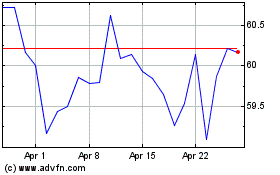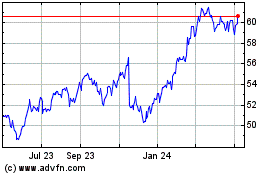By Nat Ives
The declining efficiency of traditional advertisements and new
capabilities driven by technology and data have convinced many
companies that their best shot at winning customers -- and keeping
them -- is to improve the customer experience.
Executives are getting better at thinking about experience,
according to John Maeda, the well-known designer and technologist
who was named chief experience officer at digital transformation
consulting firm Publicis Sapient last year. Mr. Maeda is a former
MIT Media Lab professor; global head of computational design and
inclusion at Automattic Inc., the company behind digital publishing
platform WordPress; design partner at Silicon Valley
venture-capital firm Kleiner Perkins Caufield & Byers; and
president of the Rhode Island School of Design.
Publicis Sapient's experience projects include the latest
version of a system to let Walmart Inc.'s customers scan products
and pay by smartphone instead of waiting in traditional checkout
lines, which is now in use in Toronto.
But experience also encompasses more than many companies expect,
Mr. Maeda said. It means the user interface on a website, customer
service and new features meant to make products easier to use. But
consumer experiences increasingly also depend on intangibles such
as the relationship they think they have with companies -- or even
the privacy policies of those companies, he said in a conversation
with The Wall Street Journal. Edited excerpts:
WSJ: What does experience mean to you?
When you look at all marketing literature, from the beginning,
the idea is that I have a product, and the product is assumed to be
good. And you have to, quote unquote, advertise it. That world has
changed. That's because companies's proximity to the customer is
different, because of these things [gestures at an iPhone]. You are
stuck to it through what are called digital products now.
Now I'm in the product and using it every day.
WSJ: Is experience also becoming more important as more
businesses try to make customers feel like members?
In the past, business was: "I'm going to make something great,
put in a box, and now someone sells it for me." You got the box;
hopefully you won't return it. Hopefully it'll last two or three
years, and you'll want to buy a new one. We don't really see you
that much.
But now it's like customers say, "I used you yesterday...What
have you done for me lately?" So that is a different kind of
muscle, one that exists in the tech world. Let's get data, improve,
get data, improve, again, again, forever. Whereas you used to just
ship the product and hope that customers love you forever. That is
a muscle that has to be learned.
WSJ: Where are the biggest openings for experience to make a
difference on the bottom line?
Technology is where the opportunity really is, and the melding
of it with the old things. And in the technology space, we think of
common things like virtual reality, augmented reality, automation,
et cetera, which are important. But what I'm thinking of right now
is, are there other facets that you don't look at, but are about
the experience?
One example I like to use is privacy. Apple's doubling down on
privacy. It's a kind of new material finish that you can't point
to, but you're like, that's got privacy built in. Another facet
that I'm trying to put a lens on is speed. People wonder why people
like using Google products. It's because Google, early on, invested
in speed.
WSJ: Can traditional, analog companies improve experience?
...Do you like Muji [the seller of household items and clothes]
products? The lead designer there once said that Muji's philosophy
is to not go after what he calls the wow effect, the first
impression. He said at Muji we look for the after wow. The after
wow is you buy it, bring it home, and after a month say, that's
good. You know? So the after wow is a deeper experience
relationship.
Most of what we award is about "wow!" Which doesn't realize a
recurring revenue service. It's a "Oh, you really marketed to me
really well, I bought it, I kind of tired of it, it isn't useful
for me." So I'm going to be looking for the after wow.
WSJ: Are companies ready to do this work?
The distance between the people who make things and sell things
is too large in a large corporation. I feel lucky that I grew up
with parents who had a tofu store in Chinatown in Seattle. I'll
never forget how my dad would make the tofu with my mom. And then
my mom would be in the front selling it. And he was a terrible
businessperson, he sold the tofu at a very low margin and it didn't
make any sense. But everyone loved my mother. They would come and
just stay there forever. My father would get upset: "Why are you
talking to the customers so long?" And it struck me how the
customer service that my mother delivered was the marketing of the
product. And he delivered the high quality product.
Most important, our policy was always to open the door for the
customer when they were leaving. Every customer wants that
experience of someone opening a door for them. And having a great
product and getting it served by someone who they want to come back
to see. So I want to get to that experience.
WSJ: How can companies measure whether their experience efforts
are paying off?
I've noticed that that's the main criticism around experience.
If you understand experience it's two loops running: One is the
marketing attraction loop and the other is a product
servicing/fulfillment loop. The return on investment you get from
the marketing loop is return on ad spending and things like that.
That is all now easy to measure in real time. On the other loop,
it's lifetime customer value. You don't see that return
immediately. You have to wait months, and years in some cases, to
provide it out.
The other metric I'm really interested in understanding is
reputation. Reputation is going to be largely proportional to
product value and lifetime value. If you were looking at a single
instant, it's not realistic. But the science is definitely
improving.
WSJ: So do you have to be patient?
Not patient. Logical. Because its only something you can measure
in larger time steps. If you're trying to measure in a quarter,
it's not possible in a product that you're trying to get people to
enjoy for a year or two years or three years.
We have to think of all products like subscription products.
Technically everything is a kind of subscription product; if you go
to the supermarket and buy apple they want you to come back and buy
apples. Nowadays how there are very few one-time products you buy,
even homes.
Write to Nat Ives at nat.ives@wsj.com
(END) Dow Jones Newswires
February 28, 2020 12:17 ET (17:17 GMT)
Copyright (c) 2020 Dow Jones & Company, Inc.
Walmart (NYSE:WMT)
Historical Stock Chart
From Mar 2024 to Apr 2024

Walmart (NYSE:WMT)
Historical Stock Chart
From Apr 2023 to Apr 2024
